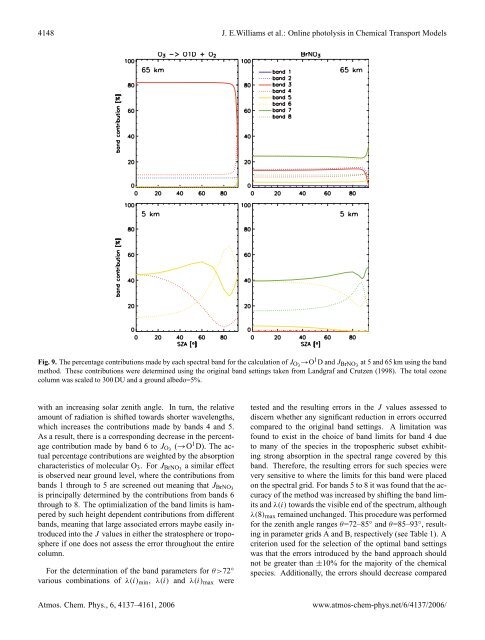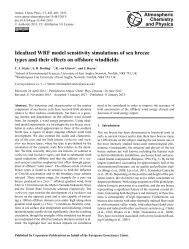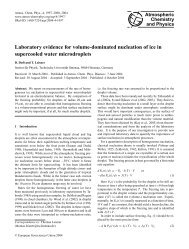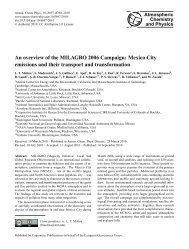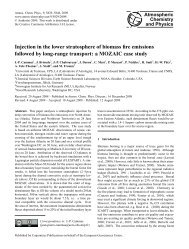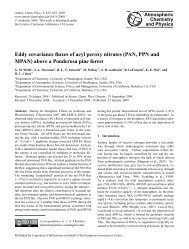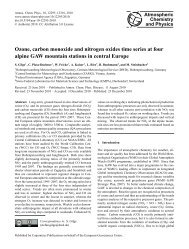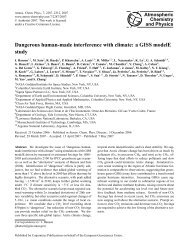A modified band approach for the accurate calculation of online ...
A modified band approach for the accurate calculation of online ...
A modified band approach for the accurate calculation of online ...
Create successful ePaper yourself
Turn your PDF publications into a flip-book with our unique Google optimized e-Paper software.
4148 J. E.Williams et al.: Online photolysis in Chemical Transport Models<br />
Fig. 9. The percentage contributions made by each spectral <strong>band</strong> <strong>for</strong> <strong>the</strong> <strong>calculation</strong> <strong>of</strong> JO3→O1D and JBrNO3 at 5 and 65 km using <strong>the</strong> <strong>band</strong><br />
method. These contributions were determined using <strong>the</strong> original <strong>band</strong> settings taken from Landgraf and Crutzen (1998). The total ozone<br />
column was scaled to 300 DU and a ground albedo=5%.<br />
with an increasing solar zenith angle. In turn, <strong>the</strong> relative<br />
amount <strong>of</strong> radiation is shifted towards shorter wavelengths,<br />
which increases <strong>the</strong> contributions made by <strong>band</strong>s 4 and 5.<br />
As a result, <strong>the</strong>re is a corresponding decrease in <strong>the</strong> percentage<br />
contribution made by <strong>band</strong> 6 to JO3 (→O1D). The actual<br />
percentage contributions are weighted by <strong>the</strong> absorption<br />
characteristics <strong>of</strong> molecular O3. For JBrNO3 a similar effect<br />
is observed near ground level, where <strong>the</strong> contributions from<br />
<strong>band</strong>s 1 through to 5 are screened out meaning that JBrNO3<br />
is principally determined by <strong>the</strong> contributions from <strong>band</strong>s 6<br />
through to 8. The optimialization <strong>of</strong> <strong>the</strong> <strong>band</strong> limits is hampered<br />
by such height dependent contributions from different<br />
<strong>band</strong>s, meaning that large associated errors maybe easily introduced<br />
into <strong>the</strong> J values in ei<strong>the</strong>r <strong>the</strong> stratosphere or troposphere<br />
if one does not assess <strong>the</strong> error throughout <strong>the</strong> entire<br />
column.<br />
For <strong>the</strong> determination <strong>of</strong> <strong>the</strong> <strong>band</strong> parameters <strong>for</strong> θ>72 ◦<br />
various combinations <strong>of</strong> λ(i)min, λ(i) and λ(i)max were<br />
tested and <strong>the</strong> resulting errors in <strong>the</strong> J values assessed to<br />
discern whe<strong>the</strong>r any significant reduction in errors occurred<br />
compared to <strong>the</strong> original <strong>band</strong> settings. A limitation was<br />
found to exist in <strong>the</strong> choice <strong>of</strong> <strong>band</strong> limits <strong>for</strong> <strong>band</strong> 4 due<br />
to many <strong>of</strong> <strong>the</strong> species in <strong>the</strong> tropospheric subset exhibiting<br />
strong absorption in <strong>the</strong> spectral range covered by this<br />
<strong>band</strong>. There<strong>for</strong>e, <strong>the</strong> resulting errors <strong>for</strong> such species were<br />
very sensitive to where <strong>the</strong> limits <strong>for</strong> this <strong>band</strong> were placed<br />
on <strong>the</strong> spectral grid. For <strong>band</strong>s 5 to 8 it was found that <strong>the</strong> accuracy<br />
<strong>of</strong> <strong>the</strong> method was increased by shifting <strong>the</strong> <strong>band</strong> limits<br />
and λ(i) towards <strong>the</strong> visible end <strong>of</strong> <strong>the</strong> spectrum, although<br />
λ(8)max remained unchanged. This procedure was per<strong>for</strong>med<br />
<strong>for</strong> <strong>the</strong> zenith angle ranges θ=72–85 ◦ and θ=85–93 ◦ , resulting<br />
in parameter grids A and B, respectively (see Table 1). A<br />
criterion used <strong>for</strong> <strong>the</strong> selection <strong>of</strong> <strong>the</strong> optimal <strong>band</strong> settings<br />
was that <strong>the</strong> errors introduced by <strong>the</strong> <strong>band</strong> <strong>approach</strong> should<br />
not be greater than ±10% <strong>for</strong> <strong>the</strong> majority <strong>of</strong> <strong>the</strong> chemical<br />
species. Additionally, <strong>the</strong> errors should decrease compared<br />
Atmos. Chem. Phys., 6, 4137–4161, 2006 www.atmos-chem-phys.net/6/4137/2006/


